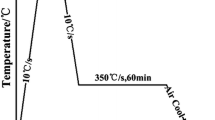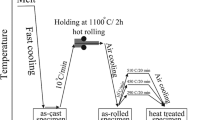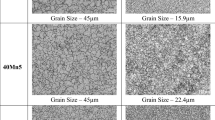Abstract
The aging control in low-carbon steels produced in continuous annealing lines is mainly performed by the boron addition, to stabilize nitrogen in solid solution. However, during the welding procedure in continuous lines, at the moment of tempering, segregation of borocarbides in the grain boundary may result in weld fillet rupture, resulting in loss of productivity. In order to verify the effectiveness of Mn on aging resistance, four steels were processed on a completely industrial scale, with Mn ranged between 0.14 and 0.29%. Among these steels, two were used with B addition, with the percentage of 0.0010 and 0.0017%, and two with no addition of this element. Among the steels with no B addition, those with the highest %Mn showed a higher aging resistance. In the steels with B addition, the aging resistance was similar, even with the different %C and %N. In this case, a higher effectiveness of C stabilization was verified in the steel with higher %Mn. The formation of manganese sulfide was indicated as an important carbide stabilization mechanism, by field-emission gun scanning electron microscopy observation. Simultaneously to variations in chemical composition, the influences of the main aging-related process parameters were studied. The result of the present study confirms the effectiveness of the addition of Mn in aging resistance in both boron-added and non-boron steels.











Similar content being viewed by others
References
X. Yuan, W. Li, Q. Pang, C. Zhang, and G. Lu, Study on the Performance and Strain Aging Behavior of Solid-Solution State Low-Carbon Steel, Mater. Sci. Eng., A, 2018, 726, p 282–287. https://doi.org/10.1016/j.msea.2018.04.099
J. Kim, K.C. Park, and D.N. Kim, Investigating the Fluting Defect in v-Bending Due to the Yield-Point Phenomenon and Its Reduction Via Roller-Leveling Process, Process. Technol, Mater, 2019, https://doi.org/10.1016/j.jmatprotec.2019.02.016
S. Koley, A. Karani, S. Chatterjee, and M. Shome, Influence of Boron on Austenite to Ferrite Transformation Behavior of Low Carbon Steel Under Continuous Cooling, J. Eng. Perform, Mater, 2018, https://doi.org/10.1007/s11665-018-3459-7
T.O.S. Souza and V.T.L. Buono, Optimization of the Strain Aging Resistance in Aluminum Killed Steels Produced by Continuous Annealing, Mater. Sci. Eng., A, 2003, 354, p 212–216
S. Watanabe and H. Otani, Precipitation Behavior of Boron in High Strength Steel, Trans. Iron Steel Inst. Jpn, 1983, 23, p 38–42
T. Hayashida, S. Sanagi, T. Kawano, Effect of Chemical Compositions and Hot Rolling Conditions on Size and Distribution Density of MnS in Hot Rolled Steels, in Proceedings of the 33rd Mechanical Working and Steel Processing Conference, St. Louis EUA, 20–22 October (The Iron and Steel Society, 1991), pp. 79–85
C.A. Suski and C.A.S. Oliveira, Análise de Precipitados por Microscopia Eletrônica de Varredura e de Transmissão em um Aço ao Boro (Precipitates Analisys by Scanning Electron and Transmission Microscopy in Boron Steel), Tecnol. Metal. Mater., 2013, 10(4), p 336–345 (in Portuguese)
M. Lückl, T. Wojcik, E.P. Karadeniz, S. Zamberger, and E. Kozeschnik, Co-Precipitation Behavior of MnS and AlN in a Low-Carbon Steel, Steel Res. Int., 2018, https://doi.org/10.1002/srin.201700342
F.J. Hunphreys, Dislocations and Properties of Real Materials, M. Loretto, Ed., Institute of Metals, London, 1985, p 175–204
P. Seraj and S. Serajzadeh, Static Strain Aging Behavior of a Manganese-Silicon Steel After Single and Multi-stage Straining, J. Mater. Eng. Perform., 2016, https://doi.org/10.1007/s11665-016-1906-x
R.R. Meira, F.M.S. Dias, and J.F.C. Lins, The Influence of Manganese on the bake hardening of Hot Dip Galvanized Low Carbon Steels, J. Mater. Res. Technol., 2019, https://doi.org/10.1016/j.jmrt.2019.12.051
X. Zheng, L. Liao, Y. Kang, W. Liu, and Q. Qiu, The Effect of Chemical Composition and Processing Technology on the Microstructure, Texture and Earing Behavior of DR Tinplate, J. Mater. Eng. Perform., 2018, https://doi.org/10.1007/s11665-018-3803-y
H. Abe, T. Susuki, and S. Okada, Decomposition of Mn-C Dipoles During Quench-Aging in Low Carbon Steels, Trans. Jpn. Inst. Met., 1984, 25(4), p 215–225
S. Das, Bake Hardening in Low and Medium Carbon Steels. D.S. Thesis, Indian Institute of Technology (2012).
V. Ballarin, M. Soler, A. Perlade, X. Lemoine, and S. Forest, Mechanisms and Modeling of Bake-Hardening Steels: Part I. Uniaxial Tension, Metall. Mater. Trans. A, 2009, 40(A), p 1367–1374
K. Chang and J.H. Kwak, Effect of Manganese on Aging in Low Carbon Sheet Steels, ISIJ Int., 1997, 37(1), p 74–79
Metallic Materials—Tensile Testing—Part 1: Method of Test at Room Temperature. ISO 6892-1, ISO, pp. 12–13 (2016)
J.D. Baird, Strain Ageing of Steel—A Critical Review, Iron and Steel, 1963, 36, p 368–374
J.D. Baird, The Effect of Strain Ageing Due to Interstitial Solutes on Mechanical Properties of Metals, Metall. Rev., 1971, 149, p 1–18
M.J. Whelan, On the Kinetics of Precipitate Dissolution, Metal. Sci. J., 1969, 3, p 95–97
A.A. Vasilyev and P.A. Golikov, Carbon Diffusion on Coefficient in Alloyed. Ferrite Materials Physics and Mechanics, Mater. Phys. Mech., 2018, 39, p 111–119
Author information
Authors and Affiliations
Corresponding author
Additional information
Publisher's Note
Springer Nature remains neutral with regard to jurisdictional claims in published maps and institutional affiliations.
Rights and permissions
About this article
Cite this article
de Meira, R.R., da Costa Ximenes, D.A. & Lins, J.F.C. The Effects of Manganese and Processing Technology on the Aging of Low-Carbon Steels. J. of Materi Eng and Perform 29, 890–896 (2020). https://doi.org/10.1007/s11665-020-04654-8
Received:
Revised:
Published:
Issue Date:
DOI: https://doi.org/10.1007/s11665-020-04654-8




